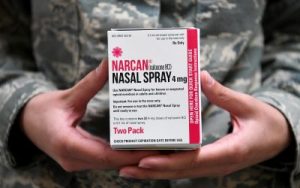
In May, at the Springfield Air National Guard Base, OH, airmen were educated by Project DAWN (Deaths Avoided with Nalaxone) on the opioid epidemic and how to administer Naloxone in an effort to help reduce opioid overdoses. Photo from by Senior Airman Amber Mullen
FALLS CHURCH, VA — In June 2018, Defense Health Agency Director Raquel Bono, MD, directed all MHS pharmacies to dispense the opioid reversal agent naloxone to eligible beneficiaries and those who request it without requiring a prescription. Since then, MHS pharmacists have provided more than 6,200 kits.
That marks a significant change in the provision of naloxone. From the date of Bono’s procedural instruction “through May 2019, naloxone prescriptions for high risk patients increased by a factor of 10,” DHA spokesman Kevin Dwyer told U.S. Medicine.
The DoD’s Basic Core Formulary now includes nasal naloxone, which is stocked at all MTF pharmacies. Naloxone auto-injectors are on the Uniform Formulary and can be provided by MTF pharmacies to meet patient needs, he noted.
“The naloxone policy is one component of the Military Health System’s multipronged opioid safety and pain management strategy,” Dwyer said.
Every day, opioid-related overdoses lead to the deaths of 130 people in the U.S., principally as a result of respiratory arrest, according to the National Institutes of Health.
“Naloxone is a very effective opioid reversal agent when administered upon recognition of an overdose. Although naloxone has been most commonly utilized in hospitals and ambulances, there was realization of a need to provide first responders, prescribers and pharmacists with improved access to naloxone for the community to increase the population health benefit and reduce adverse outcomes associated with opioid use,” Dwyer said.
As a result, the U.S. Centers for Disease Control and Prevention, Substance Abuse and Mental Health Services Administration and others have urged greater patient access to naloxone. Available as both a nasal spray and an injection, naloxone binds opioid receptors to reverse or block the effect of opioids and restores breathing when given in time.
The DHA policy and state-level naloxone access laws aim to put naloxone in the hands of individuals at risk of opioid overdoses or their friends, families or caretakers, so that the potentially life-saving medication can be administered before it’s too late.
Continue Reading:
